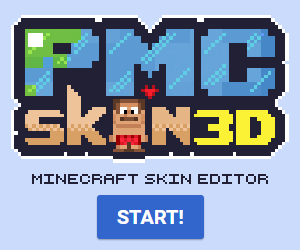Published Jun 23rd, 2014, 6/23/14 3:39 pm
- 4,562 views, 1 today
- 144 downloads, 0 today
2
Description
Professional maps make use of the permanently-loaded chunks that surround the world spawn in order to condense redstone mechanisms into one area that will work no matter where the player is in the overworld. This is extremely useful in lowering rendering lag caused by a large amount of redstone, as the playable map would be fairly far away from these chunks.
Get MCEdit here: http://www.mcedit.net
MinecraftForum Thread: http://www.minecraftforum.net/topic/1798239-
Please note that this underlay is meant for 1.7+. The spawn chunks in previous versions are shaped differently.
Explanation
Every world has a default, world-based spawning area, where players respawn at so long as their individual spawn has not been moved and is not blocked. The respawning area itself varies depending on if you're playing singleplayer or multiplayer. For example:

The BLUE glass represents the respawning area in multiplayer, restricted to a 10x10-block area. The WHITE glass represents the respawning area in singleplayer, restricted to a 20x20-block area. This should be taken note of when creating a map to be distributed.
The YELLOW stained clay represents the world spawn coordinates. These coordinates can be changed in-game with the following command:
/setworldspawn X Y ZThe chunk (a chunk being 16x16 blocks) that these coordinates lie within will determine the center of the perma-loaded spawn chunks. The chunks themselves take up a 25x25 area, though is sectioned off at specific points. Each section has its own uses, which can be represented in this picture:

LEFT:
RED (13x13 chunks):
All redstone mechanisms and regular entities are functional. Tile entities are also loaded, which are placed blocks with extra sets of data attached to them. This includes container blocks with items inside them, beacon blocks that hold the primary and secondary effects, comparator output levels, and much more.Item entities are separate from items within containers. They are the items lying freely on the ground. Other regular entities include all mobs, falling sand, projectiles, minecarts, paintings/item frames, etc.
BLUE (17x17 chunks):
All redstone mechanisms and tile entities are functional, but regular entities are not. As described above, items inside containers are not entities, but a part of the container block itself. Item entities (dropped items) are what will not function, as well as other entities. Essentially if it can increment the "E:" value on your F3 screen, it is an entity.
For example, when an items "Age" tag reaches 6,000 ticks, the dropped item will despawn. However, since the entity is not within the RED chunks, the "Age" tag will not increment as the item is not loaded. It will then be stuck at its current "Age" until it is loaded by a nearby player.
GREEN (25x25 chunks):
None of the above is functional, and I do not know what is loaded within this area that is significant. These chunks are forced regardless.
RIGHT:
This merely shows that the center of the perma-loaded chunks is where the /setworldspawn command was set to. The respawning area is not tied to the chunk, but rather to the /setworldspawn coordinates. For example:

While the respawning area takes up several chunks, the chunk the yellow wool resides in will always be the center of the perma-loaded chunks.
Usefulness
When creating a fairly complex map, access to command blocks allows map makers to perform all sorts of wireless contraptions. Keeping these contraptions within rendering distance of people playing the map will be a cause of lag. While sometimes you need to have certain contraptions within an area for mechanical purposes, most of the mechanisms can be moved to the perma-loaded chunks.
Since the perma-loaded chunks will be active no matter where the player is, the majority of the playable map can be thousands of blocks away. This puts the perma-loaded chunks outside of the rendering distance, giving the player less to render on their end, reducing lag.
This also guarantees your mechanisms will always work, so long as there is a player in the overworld. If there are no players in the overworld, but there are in the nether or end, the perma-loaded chunks will unload until a player is in the overworld. It takes 1 minute before the spawn chunks will unload should there be no players in the overworld. Also know that any mechanisms that involve entities will need to be within the 13x13-chunk area, while all redstone-exclusive mechanisms can be in a larger 17x17-chunk area.
Disclaimer
This is simply meant to help manage perma-loaded chunks. This is not a map for play, but for function.
Please let me know if you have any questions concerning the download or spawn chunks and I will do my best to answer.
| Progress | 100% complete |
| Tags |
2942797
2










Create an account or sign in to comment.